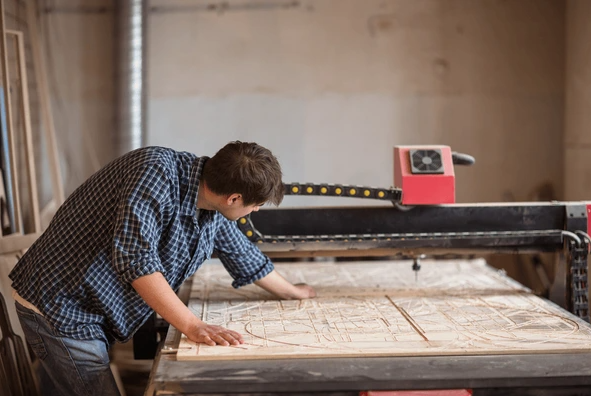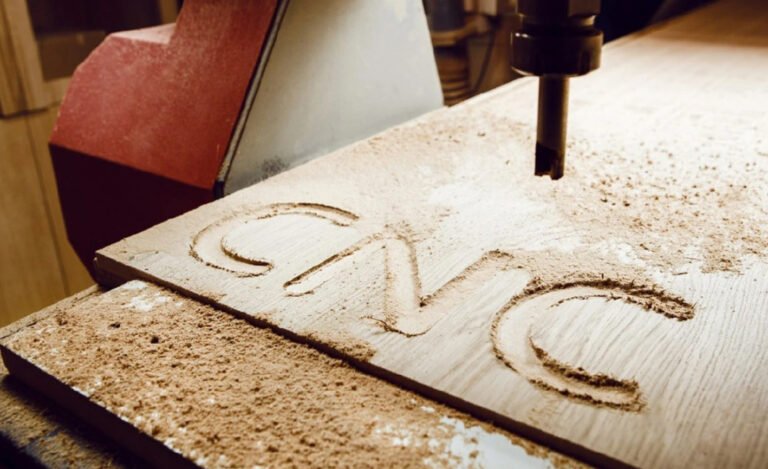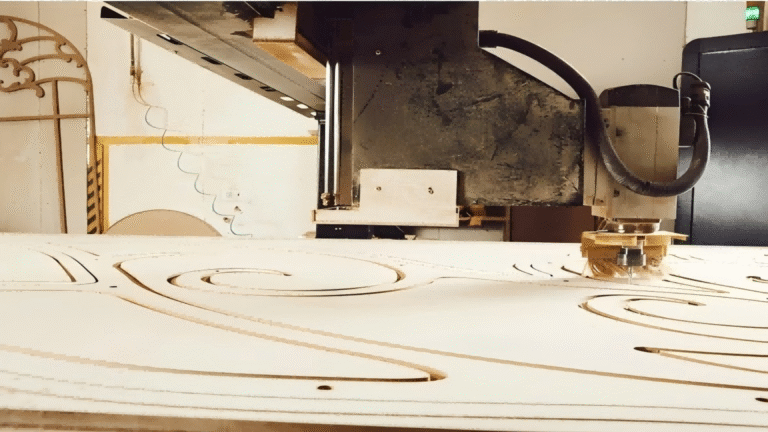“The right tool makes all the difference between a professional result and a frustrating experience,” says master craftsman Sam Maloof. This wisdom is key when picking the best tools for woodworking.
Woodworkers face a big challenge: making clean, precise holes without mistakes. The answer is to know which wood drilling bits are best for different jobs and materials.
This guide covers all, from classic twist designs to special Forstner bits. We’ll show you the best drill bits wood projects need. This includes working with hardwood, softwood, or engineered materials.
In this guide, we’ll talk about top brands like ZC Tools. They’re known for their precise tools. We’ll cover everything from basic to advanced bits. This will help you feel confident in any project.
Key Takeaways
- Different bit types serve specific purposes in woodworking applications
- Central spur points prevent slipping and ensure accurate hole placement
- Material composition affects performance and longevity significantly
- Proper bit selection reduces tear-out and splintering issues
- Quality brands like ZC Tools offer superior precision and durability
- Matching bit design to project requirements improves results dramatically
Understanding Wood Drilling Fundamentals
Learning about wood drilling science makes projects better. It’s key to know how wood and bits work together. Wood bits have special points that help them move smoothly through wood.
The lip of the bit cuts through wood fibers. This makes holes smooth and without splinters. ZC Tools uses these ideas to make great wood bits.
How Wood Grain Affects Drilling Performance
Wood grain drilling needs different methods. Drilling with the grain is easier. But drilling against the grain is harder.
Wood can be dense in some spots and soft in others. This means you need to adjust how you drill. This keeps holes the same quality.
Drill Speed and Feed Rate Considerations
Choosing the right drill speed wood is important. It stops the bit from getting too hot. For small bits in softwoods, high speeds work best. But big bits need slower speeds.
Drilling too fast can make the bit get stuck. Drilling too slow can make it too hot. The best results come from steady, consistent pressure.
Hardwood vs. Softwood Drilling Requirements
Hardwood drilling needs patience and the right technique. Hardwoods like oak and maple need slower speeds. Softwood drilling is faster but needs careful control.
Pine and cedar are softer but can splinter easily. The type of wood affects how the bit works and the hole’s finish.
| Wood Type | Recommended Speed (RPM) | Feed Rate | Special Considerations |
|---|---|---|---|
| Hardwood (Oak, Maple) | 500-800 | Slow, steady | Pre-drill pilot holes, use sharp bits |
| Medium Hardwood (Cherry, Walnut) | 800-1200 | Moderate | Monitor for heat buildup |
| Softwood (Pine, Cedar) | 1200-2000 | Light, consistent | Prevent tear-out with backing board |
| Engineered Wood (Plywood, MDF) | 1000-1500 | Moderate | Use carbide-tipped bits for longevity |
Knowing these basics helps us choose the right bits and methods. ZC Tools makes wood bits that work well with different woods. This ensures great results, no matter the wood or grain.
Essential Bits for Drilling Wood: Complete Overview
Woodworkers use four main bit types for drilling wood. These bits are key for any serious craftsman. Each bit is made for a specific job.
Knowing these bit types helps you pick the right tool for your project. We’ll look at how each bit works and when to use it.
Twist Drill Bits for General Purpose Drilling
Twist drill bits wood are very versatile. They have spiral flutes that remove wood chips well. This makes straight, clean holes.
The spiral design helps remove chips. It stops the bit from getting clogged and keeps it cool while drilling.
These bits are best for holes up to one inch. They’re great for making pilot holes and dowel joints. ZC Tools makes top-notch twist bits that work well with all wood types.
These bits work well in both handheld drills and drill presses. They’re a must for most woodworking jobs.
Spade Bits for Large Diameter Holes
Spade bits are best for big holes. They have paddle-shaped edges and a central spur for accurate starting. This keeps the bit from moving off track.
They can drill holes from 6mm to 38mm. They’re perfect for big jobs like electrical and plumbing work in wooden frames.
Spade bits cut wood fast. But, they need steady pressure and the right speed to avoid damage on the other side.
Pros like these bits for big jobs. They’re fast and efficient for lots of drilling.
Forstner Bits for Precision Flat-Bottom Holes
Forstner bits make the cleanest holes. They have a circular rim with edges that cut wood cleanly.
They’re great for making recesses for hidden hinges and hardware. Their flat bottom is different from other bits.
Most Forstner bits work better in drill presses. This controlled setting helps them cut precisely.
ZC Tools makes top Forstner bits. They’re sharp and last longer than others.
Auger Bits for Deep Hole Drilling
Auger bits wood are for deep holes in thick wood. Their threading and deep flutes remove chips well during long drills.
They self-feed, pulling through the wood. This means less pressure for you and steady speed.
These bits avoid getting stuck in deep holes. Their long flutes carry away debris from the cutting edge.
Auger bits wood are for deep holes for wiring and plumbing. They can drill through many layers at once.
| Bit Type | Best Applications | Maximum Diameter | Key Advantages |
|---|---|---|---|
| Twist Drill Bits | General purpose, pilot holes, dowels | 1 inch | Versatile, clean holes, chip evacuation |
| Spade Bits | Large holes, electrical/plumbing rough-in | 1.5 inches | Fast cutting, economical, widely available |
| Forstner Bits | Flat-bottom holes, hinge recesses, precision work | 2 inches | Clean entry/exit, flat bottoms, minimal tear-out |
| Auger Bits | Deep holes, thick timber, self-feeding applications | 1.5 inches | Self-feeding, excellent chip removal, long reach |
Each bit type has its own job in woodworking. Knowing their strengths helps you choose the best tool for your project.
Quality is key for bit performance and life. Spending on premium bits from ZC Tools means better results and longer tool life.
Specialized Wood Drilling Bits for Specific Applications
When standard bits don’t cut it, specialized wood drilling bits are the answer. They offer the precision and efficiency woodworkers need. Each type of specialized bit has its own strengths for specific tasks.
Woodworkers use these specialized bits to get better results. Investing in quality bits means better accuracy and faster projects. ZC Tools makes precision bits for professionals.
Brad Point Bits for Clean Entry and Exit
Brad point bits have a special W-shaped center point. This makes holes clean and precise. The sharp outer spurs score the wood before the main edge cuts.
These bits are great for furniture and cabinetry. They prevent tear-out and make holes look clean. Professional woodworkers choose them for their clean holes.
The cutting edges stay sharp longer than regular bits. This makes them cost-effective for big projects. There are many types of wood drilling bits, but brad point bits are best for clean holes.
Hole Saw Bits for Large Circular Cuts
Hole saw bits make big circular cuts easy. Their hollow design removes wood discs and makes round holes. They work well on thick lumber.
These bits are great for electrical and decorative work. They remove debris easily. Different teeth handle different woods well.
Professional contractors use various hole saw sizes for different projects. Coarse teeth are for softwoods, fine for hardwoods.
Countersink and Counterbore Bits
Countersink bits make recesses for screws. They drill and countersink in one pass. The cutting edge fits standard screw angles.
Counterbore bits make recesses for bolts and washers. They keep fasteners below the wood surface. ZC Tools makes precise versions for consistent results.
These bits save time by doing two tasks at once. They reduce setup time and keep accuracy high. Cabinet makers find them very useful.
Step Drill Bits for Multiple Hole Sizes
Step drill bits have graduated steps for different hole sizes. They save time by not needing to change bits. This is great for production work.
These bits are versatile for various hole sizes. They can make pilot holes and enlarge them. This is useful for different fastener sizes in one project.
Step drill bits are very efficient for production. They make it easy to have multiple hole sizes with little tool change. They are key for professional workshops.
Bit Materials and Coatings for Wood Drilling
Different materials and coatings make wood drilling better. The right choice affects how well we drill and how long our tools last. Knowing what works best helps us pick the right bits for our projects.
Today’s drill bits mix old and new tech for better results. Picking the right mix for our needs means better performance and value.
High-Speed Steel Construction Benefits
High-speed steel bits are strong and resist heat well. They are tough but not too hard, so they don’t break easily. They stay sharp a long time and are easy on the wallet.
These bits work great on wood, light metals, and more. They handle heat well, making them good for many woodworking tasks.
ZC Tools makes high-speed steel bits with sharp edges. They drill smoothly in all kinds of wood.
Carbide-Tipped Bits for Longevity
Carbide-tipped bits last a long time and work well. Their sharp edges last longer than steel. They’re perfect for tough wood and lots of drilling.
These bits stay sharp, making holes consistent. They need less changing, saving time and money. Woodworkers love them for their reliability.
Buying carbide-tipped bits saves money and boosts work speed. They handle hard materials well, making them key for modern projects.
Titanium and Black Oxide Coatings
Titanium coating bits cut down on friction and heat. They stay cooler and sharper longer. They drill easier and last longer than regular bits.
ZC Tools uses special titanium coatings for better wear and life. They drill smoothly and make clean holes, even in hard woods.
Black oxide coating fights rust and helps chips flow better. These bits last longer than regular ones and resist rust. They’re great for many woodworking tasks.
The dark coating also helps chips clear out. This keeps the bit cutting well. Black oxide coating is great for resinous woods and humid places.
ZC Tools and Top Wood Drilling Bit Brands
Choosing drill bits for wood projects is easier with the right brand. Brands known for quality and innovation are key. Knowing how brands compare helps woodworkers find the best fit for their needs and budget.
Professional Wood Bit Sets
ZC Tools drill bits are all about precision and great value. Our sets have a mix of brad point, twist, and spade bits. They are made to very high standards.
Each professional wood bit set is made of high-speed steel. It has special coatings to last longer. These sets are perfect for serious DIY projects. They make drilling easier and faster.
Brand Performance Analysis
Top premium drill bit brands have their own strengths. Milwaukee Shockwave Titanium drill bits are great for drills and impact drivers. They are versatile and useful for professionals.
Bosch Daredevil spade bits are perfect for thick lumber. They cut fast and make clean holes. ZC Tools stands out for its bit designs that cut well and make precise holes.
We look at how fast they cut, how well they make holes, and how long they last. This helps find the best brand for different needs and skills.
Budget-Friendly Options
You don’t have to spend a lot to get good drill bits. Mid-tier options are great for occasional use. They help you build up to a full set over time.
Starting with basic bits from known brands is smart. These value-oriented options are perfect for DIY projects. They offer reliable results without the high cost.
Buying bits wisely means starting with the basics. Then, add more as you get better and take on bigger projects. This way, you get the most value and quality.
Selecting the Perfect Bit Size and Type
Choosing the right drill bit is key for any wood project. It’s not just about the size of the hole. You also need to think about how the bit will work with the wood and other tools.
Woodworkers know that picking the right bit is important. It helps avoid mistakes and makes sure your work looks good. We look at the hole size and the tools needed for the project. This way, we get the best results every time.
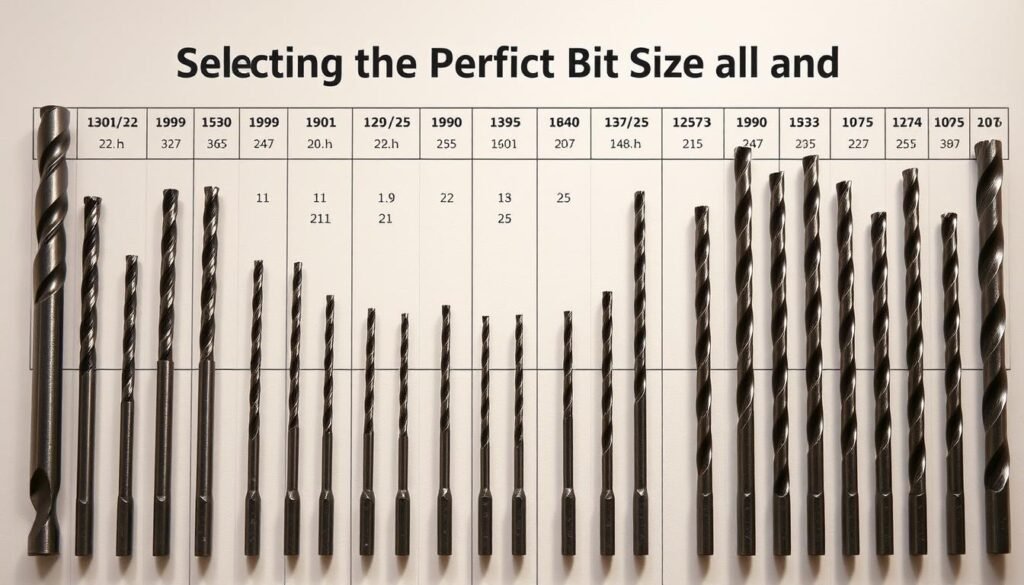
Matching Bit Diameter to Project Needs
Bit diameter matching is about more than just the hole size. We start with pilot holes for screws. These holes are 75% of the screw’s size to avoid splitting the wood.
Clearance holes need to be a bit bigger. This extra space helps with movement and wood changes with the seasons. It keeps things from getting stuck.
For big projects, like electrical work, we use bigger bits. Spade bits from 1/4-inch to 1-1/2-inch are common. These bits make clean holes without tearing the wood.
“The right bit diameter isn’t just about the hole size – it’s about understanding how that hole functions in the finished project.”
Shank Size and Chuck Compatibility
Chuck compatibility is important for good performance and safety. Home drills usually have 3/8-inch or 1/2-inch chucks. But, pros use bigger chucks for heavy work.
Quarter-inch hex shank bits are great for quick changes. They fit well with 1/4-inch impact drivers. This is helpful for doing lots of drilling.
ZC Tools makes bits for different chucks. Round shanks fit traditional chucks well. Hex shanks are for quick changes. This lets you use the best bit for each job.
Application-Specific Bit Selection Guide
Choosing the right bit depends on the woodworking task. We think about the wood, hole depth, and how precise it needs to be. This helps us pick the best bit for the job.
For making furniture, we use brad point bits. They make clean holes with little tear-out. This is important for visible joints.
Construction needs different bits. Spade bits are good for framing, and auger bits for deep holes. These bits are faster but not as concerned with looks.
ZC Tools’ application-specific bit selection guide helps pick the right bit for each challenge. It looks at the bit’s design and coating. This ensures you get the best results for your project.
Professional Wood Drilling Techniques
Learning professional wood drilling techniques makes your projects look great. These methods help you make clean holes and keep your tools safe.
First, you need to plan and do each step carefully. We focus on three key areas for top-notch results.
Proper Marking and Center Punching
Getting holes right starts with good marking and center punching. Use sharp awls or center punches to avoid bit slipping.
ZC Tools precision-ground center punches make perfect marks without harming the wood. It’s important to press just enough to make a clear mark without splitting the wood.
Here’s how to center punch right:
- Mark where you want holes with a sharp pencil
- Put the center punch straight on the surface
- Hit it gently with a light hammer
- Check the mark is deep enough before drilling
Controlling Drill Speed and Pressure
Drill speed control is key. It depends on the bit, wood, and hole quality you want. Start slow and adjust as needed.
Right pressure stops the drill from getting too hot and makes it last longer. Too much pressure can burn the bit, while too little makes it cut poorly.
Watch for these signs for the best drilling:
- Chips should keep coming off smoothly
- The drill should sound smooth, not squeal
- Drilling should feel steady, not stuck
- There should be no smoke or burning smells
Preventing Tear-Out and Splintering
To avoid tear-out and splintering, focus on how you start and end. Sharp bits and the right technique help a lot.
Entry Side Techniques
For a clean start, apply pressure slowly. This lets the bit cut wood cleanly. Start light and get firmer as needed.
Sharp bits are crucial for a clean start. Dull bits tear the wood, making holes rough and prone to splintering.
Exit Side Protection Methods
To stop splintering on the way out, use a few methods. Backing boards are the best because they support the wood as the bit exits.
Other ways include easing off pressure near the end and drilling from both sides. ZC Tools precision-ground bits help a lot with this.
Keep your bits in good shape. Let them cool, clean them, and oil them lightly. This keeps them sharp and working well.
Maintenance and Extending Bit Life
Good drill bit maintenance makes them work better and last longer. It’s more than just cleaning. It’s about keeping the edges sharp and avoiding wear.
Woodworkers know to start maintenance right after drilling. Let bits cool down before touching them. This stops damage from heat.
Cleaning Wood Debris and Resin Buildup
Cleaning wood debris needs care and the right methods. First, wipe bits with a clean, dry towel. This removes surface dirt.
Then, use a clean, dry toothbrush for tough spots. Focus on the flutes and edges. ZC Tools suggests special brushes for their sets.
Put a light oil on bits after cleaning. This stops rust and keeps parts moving well. Don’t use too much oil, as it can attract more dirt.
“Proper maintenance after every use session prevents 90% of premature bit failures and maintains cutting performance throughout the tool’s lifespan.”
Proper Storage and Organization
Good bit storage keeps them sharp and safe. Most drill bit sets come with cases. These cases keep bits from getting damaged.
Keep bits in a cool, dry place. Avoid moisture and extreme temperatures. ZC Tools cases are made to resist moisture.
Organize bits by size and type. Label storage clearly. This saves time and prevents damage.
Sharpening and Reconditioning Techniques
Sharpening drill bits is key for top performance. Learn the right sharpening angles for each bit. This keeps them cutting well.
Use quality sharpening tools or get it done by a pro. Hand-filing is okay for small touch-ups. But, precision grinding gives better results. ZC Tools offers sharpening services for their premium bits.
Know when to replace bits instead of sharpening them. Bits that are too worn or damaged won’t work well even after sharpening. Replace them if they crack, wear out, or have damaged edges.
Regular care makes drill bits last longer and work better. Stick to these tips to get the most from your tools and keep your projects looking great.
Troubleshooting Common Wood Drilling Problems
Fixing wood drilling issues is easy once we know why they happen. Dull drill bits make work take longer and can damage things. It’s key to follow the maker’s advice on how to use drill bits. Different types need different ways to solve problems.
We find four main types of drilling problems. Each has its own signs and fixes that really solve the issue, not just cover it up.
Overheating and Burn Marks
Drilling overheating happens when too much friction makes wood and tools get hot. This usually happens when the drill speed is too high for the wood and bit.
The main reason for burn marks on wood is using bits too fast for the material. Hardwoods need slower speeds than softwoods to avoid burning. ZC Tools makes bits that help keep cool and clear chips, which helps avoid overheating.
To solve this, we make three changes. First, slow down the drill to match the wood’s hardness. Second, keep bits sharp to cut cleanly, not rub. Third, drill at the right speed to remove material well.
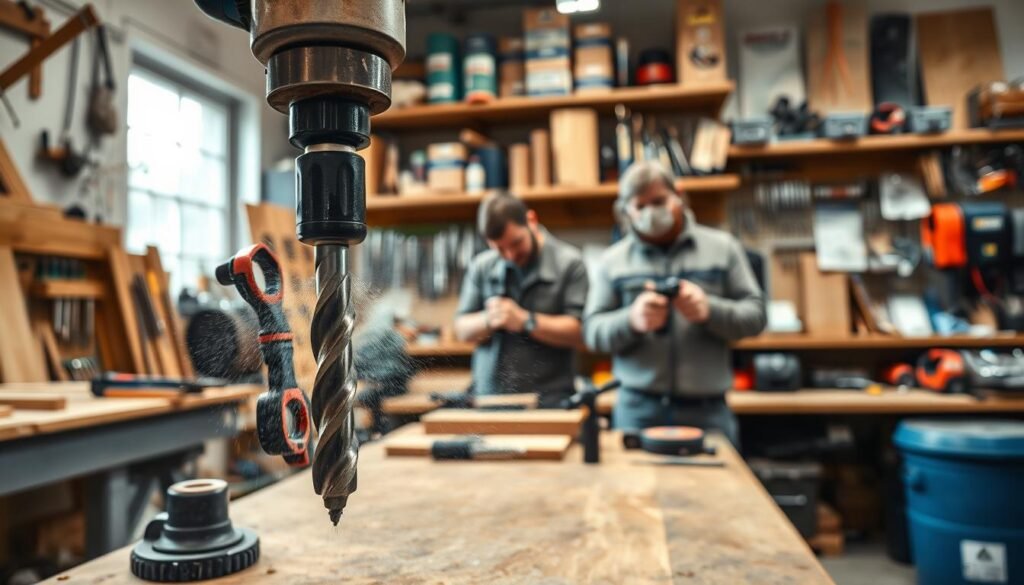
Wandering and Off-Center Holes
Hole wandering happens when starting wrong, bits are dull, or drilling technique is off. This problem shows when bits don’t cut straight but wander off.
To prevent this, start right. Use center punches or brad point bits with self-centering tips. These tools help the bit start straight and stay on track.
Drill straight and steady to avoid holes moving. Sharp bits cut well and don’t wander. Check and replace bits often to stop wandering.
Bit Binding and Breaking Issues
Bit binding happens when tools get stuck in the hole. This can break the bit and damage the work and drill.
Too much pressure is the main cause of binding. Match the bit to the job and drill right. Trying to drill too deep can cause binding and breakage.
Not clearing chips well also causes binding. Know when to pull the bit for chip clearance and drill at the right speed for easy material removal.
“The key to preventing bit binding lies in understanding your equipment’s limitations and working within those parameters consistently.”
Achieving Consistent Hole Depth
Consistent hole depth needs careful measurement and control for even results. Problems happen when we guess or drill too hard.
Depth stops are the best fix for even holes. These attach to bits and stop drilling too deep. ZC Tools helps with precise drilling through marked bits and accessories for better depth control.
Measure before drilling to set hole depths. Use tape or markers on bits for depth guides when depth stops aren’t there. This keeps holes even.
| Problem Type | Primary Cause | Prevention Method | Solution Approach |
|---|---|---|---|
| Overheating/Burn Marks | Excessive drill speed | Match speed to wood type | Reduce RPM, sharpen bits |
| Hole Wandering | Dull bits, poor starting | Use center punch, sharp bits | Brad point bits, steady pressure |
| Bit Binding | Excessive feed pressure | Proper technique, chip clearance | Reduce pressure, withdraw for chips |
| Inconsistent Depth | No depth control | Use depth stops, measure carefully | Systematic marking, accessories |
Figuring out drilling problems leads to real fixes. Knowing these issues and how to prevent them makes projects better and tools last longer. Regular care and the right technique solve most problems before they start.
Conclusion
Our guide shows that picking the right drill bits is key to good woodworking. We talked about different types of bits. Each one is good for different jobs, like twist bits and Forstner bits.
For home projects, twist or brad point bits are usually the best. They can handle most DIY tasks. Finding the right drill bit size might seem hard at first. But, it gets easier with time and practice.
Drilling well means knowing about bits, how to use them, and the wood you’re working with. It’s important to choose quality drill bits. ZC Tools makes bits that work well and last long.
Keeping your bits sharp and using them right is more important than having the latest tools. Most problems come from dull bits or using the wrong technique.
This guide says that getting better at drilling takes practice and good tools. Whether you’re a DIY fan or a pro, these tips will help you do great work with wood.
FAQ
What are the best bits for drilling wood for beginners?
Start with twist drill bits for general drilling. Use brad point bits for clean holes. Spade bits are best for big holes. ZC Tools has great starter sets.
Twist bits are good for pilot holes and small drilling. Brad point bits help avoid tear-out with their sharp edges.
How does wood grain direction affect drilling performance?
Wood grain direction is very important. Drilling with the grain is different from against it. ZC Tools makes bits that work well in all directions.
Drilling across the grain makes cleaner holes. But drilling with the grain can make holes wander. ZC Tools’ bits are made to handle different grain directions.
What drill speed should I use for hardwood versus softwood?
Hardwoods like oak need slower speeds. Use 300-800 RPM with steady pressure. Softwoods like pine can be drilled faster, 800-1500 RPM, with lighter pressure.
Start with a moderate speed. Adjust as needed to get the best results.
When should I use Forstner bits instead of regular drill bits?
Use Forstner bits for precise holes. They’re great for furniture making and cabinetry. They make holes with minimal tear-out.
Forstner bits are perfect for hidden hinges and hardware recesses. They create flat bottoms and can drill partial holes.
What’s the difference between brad point bits and regular twist bits?
Brad point bits have a W-shaped center and sharp edges. They make clean holes. Regular twist bits are good for general drilling but may tear more.
Brad point bits are best for furniture making. They ensure clean holes.
Are carbide-tipped bits worth the extra cost for wood drilling?
Carbide-tipped bits are great for professionals. They stay sharp longer. For DIY, high-speed steel bits from ZC Tools are often better value.
How do I prevent tear-out when drilling through wood?
Use sharp bits and proper center punching. Apply gradual pressure at entry. Use backing boards at exit points.
Drill from both sides for thick stock. Brad point and Forstner bits naturally reduce tear-out. ZC Tools’ bits almost eliminate tear-out with the right technique.
What size drill bits do I need for common wood screws?
Use bits 75% of the screw’s root diameter for pilot holes. Common sizes include: #6 screws need 7/64″ bits, #8 screws need 1/8″ bits, #10 screws need 9/64″ bits, and #12 screws need 5/32″ bits. For clearance holes, use bits matching the screw’s shank diameter. Always test on scrap wood first.
How do I know when my drill bits need sharpening?
Bits need sharpening if they require too much pressure, produce powder, burn wood, or create rough holes. Check cutting edges for chips, nicks, or dullness. ZC Tools offers sharpening services for their professional-grade bits.
What’s the best way to drill deep holes in thick lumber?
Auger bits are great for deep holes. They have aggressive threading and deep flutes for efficient chip removal. Periodically withdraw the bit to clear chips and use steady pressure without forcing.
Ensure adequate chip evacuation to prevent binding. For holes deeper than 3 inches, use extension shanks or specialized long-reach bits.
Can I use wood drilling bits in a cordless drill?
Yes, most wood drilling bits work well in cordless drills. Make sure your drill has enough torque for the bit size and application. Hex shank bits provide superior grip in cordless drill chucks.
ZC Tools makes bits for different drill types.
How do I choose the right bit for drilling pocket holes?
Use specialized stepped bits or auger bits for pocket holes. Bits designed for pocket hole jigs are usually 3/8″ diameter. They should have aggressive cutting action for smooth, angled holes.
What causes drill bits to bind or break during wood drilling?
Bit binding is often due to too much pressure, bad chip clearance, dull bits, or drilling beyond their limits. Use proper technique, keep bits sharp, and clear chips regularly. Match bit selection to the job.
Forcing dull bits or using wrong speeds can cause binding and breakage.
How should I store my wood drilling bits to maintain their sharpness?
Store bits in a dedicated system that keeps each bit separate. Use cases, strips, or blocks to prevent damage. Clean bits well before storing to remove debris and prevent rust.
Keep them in dry places to avoid rust on the cutting edges.
What’s the advantage of titanium-coated drill bits?
Titanium coatings reduce friction and heat, leading to smoother drilling and longer tool life. ZC Tools’ advanced titanium nitride coatings help bits stay sharp longer. These coatings are great for tough wood and production work.

